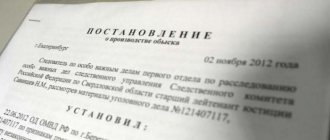Theft by a group of persons by prior conspiracy:
Such theft occurs if criminals agree to commit it some time in advance, distributing roles or appointing co-perpetrators.
The size of the stolen property does not matter. To determine the actions of the perpetrators, it is necessary to find out whether there was in fact such an agreement before the start of illegal acts, whether roles were distributed for the purpose of carrying out the theft, and what actual actions were performed by all the perpetrators or accomplices, as well as to evaluate the evidence of the theft.
The main difference between theft and other types of theft
The chapter dealing with crimes against other people's property reveals in different articles the types of criminal liability for various forms of theft. To correctly qualify an illegal act, it is necessary to know the main differences between theft and other forms of theft (robbery, robbery, fraud, misappropriation and embezzlement).
The main difference and one of the signs of the objective side of theft is the method of action. Unlike the main types of theft (burglary and robbery), theft is characterized by the secrecy of the nature of taking someone else's property. This is expressed in the fact that when committing a crime, the offender does not exert any physical or mental pressure on the victim or third parties and does not apply any types of violence to them.
The seizure of property occurs not against the will of the victim, but without taking it into account. The actions of the perpetrator are secret to the victim and the people around him (if they are present), or they do not realize that what is happening is theft. For example, if a person disguised as a repairman takes out a computer supposedly to be repaired. At the same time, those around him do not perceive his action as theft, since they are confident in the legality of removing the item.
When committing a theft of a secret nature, the thief assumes the absence of witnesses to the crime, relies on his skills and the inattention of the owner (or another person guarding the thing).
The objective side of the theft also includes the attitude of the victim and witnesses to the theft. In addition, the attitude of strangers is taken into account. Bystanders are eyewitnesses to a criminal offense who are not related to the crime or the perpetrator. Accomplices of the act, as well as relatives, friends or acquaintances of the offender are not considered strangers. This is due to the fact that the criminal is confident that there will be no obstacles on their part to commit the crime.
If the theft is committed in places where, by definition, there cannot be witnesses (a garage, a store closed at night, a warehouse, an unguarded area), the criterion of secrecy is not questioned. If the criminal understands that at least one person can see him, his action will not be classified as theft under Art. 158. The objective side in the form of the criterion of openness makes theft robbery.
If the victim realizes that his property is being stolen, but the thief does not know about it, the act remains secret. If the thief objectively realizes that no one will notice him (there is no security, the owner is asleep or drunk), his actions also qualify as theft. If he is seen at the time of theft, but he does not suspect it, the crime is considered the same.
In the case when the criminal realizes that he has been discovered and stops the theft attempt, leaving the item of theft, the classification of the crime changes to attempted theft. If the theft continues, it becomes robbery.
Secret theft is also the theft of things from obviously insane or incompetent persons (children, mentally ill, drunk, sleeping, etc.).
Theft involving an organized group
An organized group is a specific group of criminals that have united to commit a specific crime. The conspiracy must occur before the actual theft. It is important to note that the agreement of those participating in an organized group is not the usual agreement of specific illegal acts, but a detailed detailing of these actions of any accomplice, the development of methods for the best implementation of theft. Close ties are established among the accomplices, frequency of contact is established to develop and specify subsequent acts, and in addition there is a special type of relationship for joint actions during the theft.
Method of theft
The next sign of the objective side of theft is the method of its commission. In relation to this method of theft, the method is the removal, extraction or any other option of separating property from the legal possession of the owner for the simultaneous transfer of things into the illegal actual possession of the criminal.
The essence of criminal possession is the ability to freely dispose of property within certain limits (take away, hide, spend, transfer to an accomplice, etc.). In this case, the right of ownership remains with the owner, and the right of disposal passes to the offender. Conversely, the owner cannot dispose of the thing, and the criminal cannot openly possess it.
Theft from a bag, clothing or carry-on luggage carried by the victim
When determining this characteristic in the practice of a theft lawyer, it is noted that the increase in criminal punishment for it is directly proportional to the high degree of social threat of pickpocketing and similar secret thefts due to the excellent level of training of criminals. This crime is carried out not just in the presence of the victim, who is not able to notice this secret theft, but through physical contact with him or with material values located next to him or within his sight.
The concept of the objective side
The objective side of the crime of theft, like any other, is a set of signs defined by law that characterize the external expression of an encroachment on an object that is dangerous to society, which is protected by criminal or administrative law.
Disclosure of the content of a criminal offense, its consequences and other signs of an objective type allows us to consider the committed act in full and in the future easily analyze its specific forms.
In relation to theft, the objective side consists of actions that are expressed in the gratuitous and illegal seizure by the criminal of things that do not belong to him, for his own benefit or for the benefit of third parties, as a result of which the owner suffers property and moral damage.
Theft causing significant damage
To include this type of theft as part of the crime, a detailed assessment of the victim’s financial situation, level of income, material assets, etc. is carried out. At the same time, through the Criminal Code, the minimum amount of the amount for theft of which is formed in a criminal case was determined: two and a half thousand rubles. Usually, in case of theft for an amount not exceeding ten thousand rubles, under paragraph “c” of Part 2 of Art. 158 of the Criminal Code of the Russian Federation, it is not possible to initiate this criminal case. In such a situation, it is the victim of the theft, with the help of a theft lawyer, who needs to prove in court that the material damage caused was significant for him for a number of reasons.
Features of theft
To establish the fact of seizure, the presence of several essential circumstances is necessary - the characteristics of the crime committed. These features of the objective side of theft are as follows:
Property that is the object of a criminal attack, at the time of theft, is under the control of the owner (in his fund) or another person authorized by the owner. The item of theft is listed on the balance sheet of a legal entity or is considered only received and not officially registered, or is in the hands of an individual – the owner. If the property is on its way to the owner, its removal is not considered theft.
To qualify an act as theft, the offender must unlawfully remove an item from the owner’s funds without having the authority to own or dispose of it. The action must express the seizure of a thing against the will of the owner in order to turn it into one’s own benefit.
Causal relationship
The next element of the objective side of theft is the relationship of a cause-and-effect nature between the active illegal actions of the criminal, which were expressed in the seizure of someone else’s property and turning it into one’s own benefit or the benefit of others, and the resulting dangerous consequences for society in the form of real damage to the owner of the thing or its other owner. material damage.
When investigating single crimes under the one hundred and fifty-eighth article of the Criminal Code of the Russian Federation, no problems or difficulties arise in establishing a cause-and-effect relationship between theft and causing property damage, since this connection is obvious. If in a criminal case the fact of seizure of an item and causing damage precisely because of theft is proven, there is no need to establish a cause-and-effect relationship.
Problems may arise when investigating group thefts that occur over a period of time. Difficulties in establishing a cause-and-effect relationship occur if the composition of the criminal group changed during the period of criminal activity.
In this case, the actions and moment of entry into the group of each individual participant are investigated in a special manner. Law enforcement agencies calculate how much damage was caused by the group at each stage, since no one has the right to accuse a criminal of causing damage before he joins the group of offenders.
As an objective aspect of a crime (theft), the cause-and-effect relationship in the investigation of group crimes is considered the most difficult to prove. In this case, the mechanism of causing damage (harm) in relation to property is the gradual development of links of cause-and-effect nature, interconnected, which were generated by the illegal encroachment of a criminal entity. This is an illegal influence on an object, that is, an unlawful change in the position of a thing in the structure of social relationships, which entails depriving the owner of the thing of the opportunity to freely carry out actions to own, dispose and use the thing. The result of this relationship is a violation of the proper functioning of proprietary relations.
Discovering crimes under Article 158 of the Criminal Code of the Russian Federation is difficult if the crime is a group crime or there are no witnesses. In this case, all elements of the objective side are subject to careful study with the putting forward and testing of various hypotheses in order to establish the truth.
Action
The next sign that characterizes theft is the commission of active actions by the culprit. From an everyday point of view, action is body movements or human actions. The criminal law definition of an action is as follows: an action is a set of actions and movements that are aimed at committing illegal actions.
An action as an element of the objective side of theft must have the legal and social characteristics discussed above - be socially dangerous and illegal. In this regard, actions prohibited by criminal law, which are illegal, but due to their insignificance do not pose a danger to society, are not crimes.
The actions consist of seizure, that is, the movement by the criminal of a movable object in space, as a result of which the legal possession of the owner is eliminated, and the actual seizure of the property of another person. The processes of seizure and possession are inextricably linked and therefore in most cases they are carried out within the framework of one process of illegal activity.
The end of the theft
To correctly establish the composition of theft (object, subject, objective side and subjective side), it is necessary to determine the moment of completion of the crime. There are three theories: touching, carrying away and taking over. According to the first theory, the final moment is touching the item of theft. According to the second - the moment of picking it up. According to the third, from the moment the seizure is completed, when the criminal owns the thing and can freely dispose of it.
The first two theories in modern legislation express such a type of offense as attempted theft. If at the time of the theft the criminal touched the thing or attempted to take it away, but was prevented in a timely manner, this is an attempt.
If the offender has taken all successful steps to ensure that the thing is removed from the possession of the owner or other legal owner and placed at the disposal of the thief, this is classified as theft.
According to the norms of criminal law, the theft is over:
- from the moment someone else’s property is turned to the benefit of a criminal or another person;
- from illegal seizure of someone else's property;
- from the moment that material damage was caused to the owner or other possessor of the thing by unlawful seizure and handling.
Methods of withdrawal
The next element of the objective side of theft is the method of seizure. There can be two of them: legal or physical. The physical method of seizure involves moving a thing in space, when the item of theft actually goes from the possession of the owner or other legal owner into someone else’s illegal use. This method of seizure is only suitable for movable property.
The legal method of seizure is the unlawful transfer of ownership of a thing and a change in the subject of ownership. In this case, we are talking about theft of immovable property. Often, when the subject steals, the object and the objective side are not considered from the legal method of seizure.
Composition of robbery
The object of the crime is social relations that develop in the sphere of distribution and redistribution of material goods and belong to the category of “property”. Robbery is characterized by a complex object, since the attack is carried out not only on relations related to the distribution and redistribution of material goods, but also on the health of the victim.
Subject of the crime : a sane individual who has reached the age of 14 years.
Subject of robbery : other people's property.
Purpose : gratuitous seizure of someone else's property.
Intent : self-interest.
Motive : straight.
The objective side of the crime is expressed, firstly, in the commission of an attack, and secondly, in the mandatory use of violence dangerous to the life and health of the victim, or in the threat of using such violence. Consequently, both attack and the use of physical or mental violence are mandatory elements of robbery.
Subjective side of the crime : guilt in the form of direct intent and selfish purpose.
Construction of the corpus delicti : truncated corpus delicti.
The crime is completed when the offender has committed the attack, even if he was unable to take possession of the property.
Example
You can consider the same example of robbery, only in the case of robbery, the criminal first stabs the victim with a knife and disappears.
Consequences
Robbery committed without qualifying characteristics is punishable (according to Part 1 of Article 162 of the Criminal Code of the Russian Federation):
- forced labor for up to five years;
- or imprisonment for a term of up to eight years with a fine of up to five hundred thousand rubles;
- or in the amount of wages or other income of the convicted person for a period of up to three years or without it.
Committing robbery by a group by prior agreement, as well as with the use of weapons or with the use of objects used as weapons, is punishable (according to Part 2 of Article 162 of the Criminal Code of the Russian Federation):
- imprisonment for a term of up to ten years with a fine of up to one million rubles;
- or in the amount of wages or other income of the convicted person for a period of up to five years or without it and with restriction of freedom for a period of up to two years or without it.
Qualifying features:
- committing robbery with illegal entry into a home, premises or other storage;
- committing robbery on a large scale.
In these cases, the crime is punishable (according to Part 3 of Article 162 of the Criminal Code of the Russian Federation):
- imprisonment for a term of seven to twelve years with a fine of up to one million rubles;
- or in the amount of wages or other income of the convicted person for a period of up to five years or without it and with restriction of freedom for a period of up to two years or without it.
Qualifying features:
- robbery by an organized group;
- committing robbery on an especially large scale;
- causing grievous harm to the victim's health.
In these cases, robbery is punishable (according to Part 4 of Article 162 of the Criminal Code of the Russian Federation):
- imprisonment for a term of eight to fifteen years with a fine of up to one million rubles;
- or in the amount of wages or other income of the convicted person for a period of up to five years or without it and with restriction of freedom for a period of up to two years or without it.
How are they different from each other?
The distinction should be made based on the following characteristics.
| Theft | Robbery | Robbery | |
| Having a desire to remain unnoticed | the criminal wants to remain undetected | the criminal's actions are carried out openly and with complete disregard for their illegality | the criminal also commits acts openly |
| Use of violence | violence is not used in any form | violence is either absent or used without threat to the life and health of the victim | the use of violence is mandatory |
| Level of responsibility | punishable by imprisonment for a term of up to five years or compulsory labor for a term of up to 480 hours and a fine | punishable by forced labor for a term of up to five years or imprisonment for a term of up to five years and a fine | punishable by imprisonment for up to ten years and a fine |
Illegality and gratuitousness
The next feature that combines the objective and subjective sides of theft is illegality. It lies in the fact that the object of theft must be obviously alien to the criminal, not belonging to him either in law or in fact. The offender cannot have any perceived or actual right to the item stolen.
Also, illegality occurs when the guilty person in certain situations has access to a thing, but does not have authority in relation to it (for example, if we are talking about the theft of products by a store security guard or seller).
Back in the Soviet Union, the Plenum of the Supreme Court in 1962 determined that theft will be qualified as theft, and not misappropriation or embezzlement, if the guilty person is not vested with any powers in relation to the stolen property, but could use it to perform his work or had access to it access despite the fact that it was entrusted to unauthorized persons. This explanation has been used by law enforcement and judicial authorities to this day.
Illegality as an element of the objective side of theft and a subtype of illegality consists in committing theft in one of the six ways specified in the Criminal Code. If the seizure of an item occurs in a manner that is not established by law as a type of theft, it will not be an illegal theft.
The next element of the objective side of theft is the gratuitousness of the action of taking someone else’s thing. An action is considered gratuitous when it is carried out without appropriate compensation (free of charge), or the amount of compensation is inadequate or symbolic. Compensation can be expressed in the form of payment of funds, transfer of property equivalent to the stolen property, or labor costs.
According to the explanations of the legislation, theft is the theft of things or objects by replacing them with objectively less valuable ones. An example of such theft is often the theft of cultural objects, paintings or jewelry, when fakes are placed in their place.
In case of theft by substitution, the amount of damage will be calculated by determining the difference in the value of the stolen property and its replacement, if the substitute item meets the consumer normal qualities of the stolen item. If the replacement does not have the appropriate properties, the calculation will be made in the amount of the value of the stolen object.
The objective side of theft, having the attribute of gratuitousness, connects it with another - the onset of dangerous consequences for society in the form of causing material damage to the owner of the thing or another legal owner. The minimum amount of material damage received is not defined by criminal law. The law establishes only some boundaries that make it possible to determine the elements of the crime (along with the collective nature of theft and illegal entry into a home). The objective side of the theft will still include the onset of negative financial consequences.









